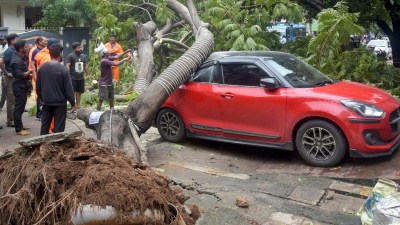Nagaland: Down the road where 6 killed in ambush, mines a lifeline for Tiru
While the landowners are slightly better off, all of Oting village's 192-odd families are connected to the mines in some way.
 One of the mines where the locals work in Mon district.
One of the mines where the locals work in Mon district. Every single week between October and May, for years, Phonei, 29, and Mary, 18, have followed the same routine. To the mine on Monday, back on Saturday, at Church service on Sunday. Often, they go down the same route where six of their colleagues were shot dead by the Army on December 4.
This is why they find the claim of the shooting being the result of “mistaken identity” hard to believe.
Having come up over the past 15 years, mines are a lifeline for Tiru valley, located about 6 km from Oting village, where the six miners killed were from, as are Phonei and Mary. Other mines are spread out over Nokzang, Wakching and Pogong areas of Mon district. A few tea plantations and broom grass and paddy cultivation are the other means of subsistence, but offer very little income.
As per figures shared by the government in Parliament in 2019, Nagaland has the highest unemployment rate among the states at 21.4%.
“Mines are the only way they can get money,” says an official of the Directorate of Geology and Mining, Nagaland.
The six miners took a shorter route home that day, instead of the road villagers call ‘Pioneer’ built in the 1990s by the government and now “dilapidated”. An Oting local, who holds a government job in Mon village, says: “It was not just them… it is the route the villagers use more often, on foot, on vehicles. It’s not in great shape but it is quicker.”
Under Article 371(A), which guarantees special rights to the Nagas with regard to ownership of land and resources, among other things, villagers own the land where the mines are located. “The government has little to do with it. The village landowners are in business with private companies from outside the state, such as Assam, Gujarat and Andhra Pradesh… Most have proper licences too,” says the mining official.
Chemwang Konyak, 56, whose son Shomwang died in the Army ambush, also owns a mine. “I have been ill so Shomwang took care of all the mine-related work. He was supervising at the mine on that day,” he says.
Even Chemwang’s pick-up truck, on which the six miners were travelling when shot, is a regular sight in Tiru valley, rented by villagers to travel. “I have had it for three years, and it has gone on that route (of the ambush) countless times,” he says.
Adds N Konyak, a local mine owner and contractor who lives in Mon: “It is not like there was movement on the road for the first time… There is no hisaab (count) of how many of our girls and boys work there and travel on that route. So how could they (the Army) make such a big mistake?”
While the landowners are slightly better off, all of Oting village’s 192-odd families are connected to the mines in some way. “Some work as security guards, others are machine operators, labourers, or JCB excavator drivers,” says the government worker from Mon, adding that money from it, despite the “exploitative” work, has helped people acquire amenities like bikes and smartphones. While Tiru has only open cast mines, the hilly areas have rat hole mines which are considered dangerous.
A civil society leader from Mon town says that before the mines came up, there was rampant illegal logging. “Tiru area was full of thick forests… Now most trees are cut down, so mining has replaced logging,” he says, adding that it has severely impacted the environment, including the rivers.
A 30-year-old, a mother of two, says that on a really good day of collecting coal, “we can make up to Rs 1,000”. Given that in the rainy season earnings drop to Rs 200-500 a day, she says they don’t mind the hours from “morning till sunset” or the temporary camps for the night.
Phonei, who is an orphan, points out that despite an BA degree, he did not get any job. “At least the mine is decent money.” Mary dropped out in Class 8. Both do the same work at the mine: collect coal left behind by the big machines.
On December 4, after a week of hard toil, Phonei and Mary were about to head home when they first heard loud sounds of gunfire. “We knew something was not right, so we waited, took the longer route and went to another village,” says Phonei.
They learnt about the Army ambush and what had happened later. Apart from the six miners killed in Army firing, two were injured and are battling for their lives. Six others died in firing to control a mob of villagers protesting against the killings.
“It is unbelievable. It could have been any of us too,” says Mary.
While the anger against the Army is palpable, some in the village admit “a good relationship” with the security forces. “Since we are close to the Myanmar border, there has always been an Army presence,” says a church leader of Oting village. “We give them wood, water, chickens… They have donated us chairs,” he says.
A mine contractor, who does not wish to be named, says several mine owners support the Army presence. “Underground insurgent groups who run parallel systems of taxation often demanded money from the owners. The Army proved a deterrent,” he says, adding that he fears that the relationship “would not mend”.
Three days after the incident, the mine workers of Oting were yet to return to work. But they know they would have to, and down the same road. “Why would we not? We are not scared. There is no place for fear any more. We are only angry,” says Mary.





- 01
- 02
- 03
- 04
- 05


























